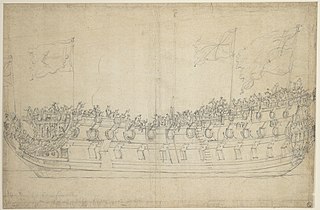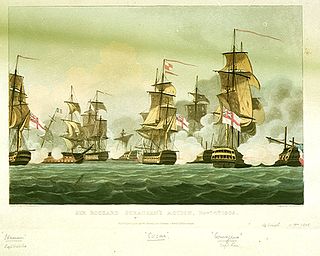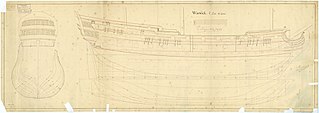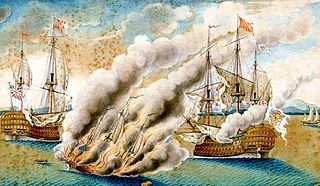
HMS Stirling Castle was a 70-gun third-rate built at Deptford Dockyard, in 1678/79. She was in active commission for the War of the English Succession, fighting in the Battles of Beachy Head and Barfleur. HMS Stirling Castle underwent a rebuild at Chatham Dockyard in 1699. She was in the Cadiz operation in 1702. The ship was wrecked on the Goodwin Sands off Deal on 27 November 1703. The remains are now a Protected Wreck managed by Historic England.
HMS Northumberland was a 70-gun third-rate ship of the line of the Royal Navy, built by Francis Bayley of Bristol in 1677/79. She partook in the last great battle of the War of English Succession and the first battle of the War of Spanish Succession. She was lost in the Great Storm of November 1703.

HMS Courageux was a 74-gun third rate ship of the line of the Royal Navy, launched on 26 March 1800 at Deptford. She was designed by Sir John Henslow as one of the large class 74-gun ships, and was the only ship built to her draught. Unlike the middling and common class 74-gun ships, which carried 18-pounder long guns, as a large 74-gun ship, Courageux carried 24-pounders on her upper gun deck.

HMS Captain was a 70-gun third rate built at Woolwich Dockyard in 1677/78. After sitting in Ordinary for ten years she was in active commission for the War of the English Succession fighting at Beachy Head and Barfleur. She was in Ordinary until 1706 when she was rebuilt. She was in active commission for the last half of the War of Spanish Succession but fought in no major engagements. She was at the Battle of Passero I 1718. She was rebuilt in 1720/22. She made two forays in to the Baltic though the bulk of her late career was spent as guardship at Portsmouth. She was hulked in 1740 and finally broken in 1762.

HMS Hampton Court was a 70-gun third rate ship of the line of the Royal Navy, launched at Deptford Dockyard in 1678. Her initial commission was to move her to Chatham where she spent in the next ten years in Ordinary. She held an active commission for the War of the English Succession, participating in the Battles of Beachy Head and Barfleur. She was rebuilt at Blackwall in 1699/1701. During the War of Spanish Succession she served mainly in the Mediterranean. In 1707 she was taken by the French and incorporated into the French Navy for four years. She was sold to the Spanish in 1712. She was wrecked in Spanish service off the coast of Florida in a hurricane in 1715.

HMS Lenox was a 70-gun third rate built at Deptford Dockyard in 1677/78. She was in active commission for the War of English Succession fighting in the Battles of Beachy Head and Barfleur. She was rebuilt in 1699. Again in active commission for the War of Spanish Succession fighting in the Capture of Gibraltar and the Battle of Velez Malaga. She followed this with the Battle off Passero. She was rebuilt again in 1721. She was active in the War with Spain, capturing the Princesa then serving in Home Waters, the Mediterranean and finally the West Indies. She was in action off Havana in 1745. She returned home and was placed in Ordinary. She was finally sunk as a breakwater at Sheerness in 1756.
HMS Berwick was a 70-gun third rate ship of the line of the Royal Navy, built at Chatham Dockyard during 1677/1679. After completion she was placed in Ordinary for 10 years. She was commissioned for the War of the English Succession 1689-1697, participating in the battles of Beachy Head and Barfleur. She was rebuilt between 1697 and 1700. She was commissioned for the War of Spanish Succession 1702-1712, participating in the battles of Vigo Bay, Capture of Gibraltar and Velez Malaga. placed in Ordinary in 1712, she was converted to a hulk at Portsmouth in 1715 before being broken in 1742.
HMS Burford was a 70-gun third rate ship of the line built at Woolwich Dockyard in 1677/79 as part of the Thirty Ships Programme of 1677. She fought in the War of the English Succession, including the Battle of Barfleur, before being rebuilt at Deptford in 1699, remaining as a 70-gun third rate. During the War of Spanish Succession she was mostly in the Mediterranean fleet and fought at the capture of Gibraltar and the Battle of Málaga in 1704 before being extensively repaired between 1710 and 1712 at Portsmouth Dockyard. Burford served in the Baltic in 1715 and 1717 before returning to the Mediterranean to fight the Spanish at the Battle of Cape Passaro in 1718. She was wrecked on the Italian coast in a storm on 14 February 1719.

HMS Eagle was a 70-gun third rate ship of the line of the Royal Navy, built at Portsmouth Dockyard during 1677/79. When completed she was placed in Ordinary for 10 years. She was in active commission during the War of the English Succession partaking in the Battle of Barfleur. She was rebuilt in 1699 at Chatham. She again played an active role in the early part of the War of Spanish Succession participating in the Capture of Gibraltar, and the Battle of Velez Malaga. She was wrecked in the Isles of Scilly in October 1707.
HMS Elizabeth was a 70-gun third rate built at Barnards Yard at Deptford Green by William and Robert Castle of Rotherhithe in 1678/80. She held an active commission during the War of the English Succession fighting in all three major engagements. She was rebuilt at Portsmouth between 1699 and 1704. She was captured by the French off the Scilly Islands in November 1704. She was in the French Navy until she was deleted in 1720.

HMS Essex was a 70-gun third rate built by Sir Henry Johnson of Blackwall in 1678/79. During the War of the English Succession she fought in the last major action. She was rebuilt in 1699/1700. During the War of Spanish Succession she fought at Vigo Bay, the Capture of Gibraltar and Velez Malaga. She also fought at the Battle off Passero in 1718. She was rebuilt again in 1736-40. She was in action off Toulon in 1744. She was active in the Channel and against French ports during the Seven Years War. She fought at Quiberon Bay in 1759. She was wrecked in Quiberon Bay in November 1759.

HMS Expedition was a 70-gun third-rate ship of the line built at Portsmouth Dockyard in 1677/79. She was in active commission during the War of the English Succession participating in the battles of Beachy Head and Barfleur. She was rebuilt in 1699. Again, for the War of Spanish Succession she was in commission for the operation at Cadiz then returned to England where she sat for two years. She was in the Mediterranean for the Battle of Marbella in 1705. She then went to the West Indies and fought in Wager's action off Cartagena in 1708. She was rebuilt in 1709-14 to the 1706 Establishment. She spent her time split between the Baltic and as guard ship at Portsmouth before being broken at Portsmouth in 1736. She was rebuilt in 1736/40 at Deptford Dockyard.
HMS Grafton was a 70-gun third rate built at Woolwich Dockyard in 1677/79. She was delivered to Chatham and placed in Ordinary in 1679. She was commissioned in 1683 to participate in the evacuation of Tangier, Morocco. She served during the War of the English Succession fighting in the Battles of Beachy Head and Barfleur. She was rebuilt in 1699/1701. She was in active commission during the War of Spanish Succession. She fought in the Battle of Vigo, the capture of Gibraltar and the Battle of Velez Malaga. She was taken by the French in 1707 and incorporated into the French Navy. Finally, being broken at Brest in 1744.

HMS Kent was a 70-gun third rate ship of the line built by Sir Henry Johnson of Blackwall in 1677/79. She served during the War of English Succession 1699 to 1697, participating in the Battle of Barfleur. She was rebuilt in 1697/99. She served during the War of Spanish Succession 1702 to 1712 and partook in the Battles of Vigo and Velez-Malaga. She partook in the Battle of Passaro then served during the short war with Spain, December 1718 to February 1720. She was rebuilt in 1722/26. She spent the next thirteen years as a guard ship at Portsmouth. In the 1740s, she was off Cape Finisterre then in the West Indies. She returned home and was finally broken in 1744.
HMS Pendennis was a 70-gun third rate ship of the line of the Kingdom of England built at Chatham in 1677/79. She was in the War of English Succession. She was in the Battle of Bantry Bay. She was wrecked on the Kentish Knock in October 1689.
HMS Exeter was a 70-gun third rate ship of the line of the Kingdom of England, built by contract Sir Henry Johnson at Blackwall under the 1677 Construction Programme. She was at the Battle of Beachy Head in 1690. She was accidentally burnt at Plymouth in 1691. Her remains were hulked at Portsmouth until she was broken in 1717.

HMS Burford was a 70-gun third rate ship of the line of the Royal Navy, built at Deptford Dockyard to the 1719 Establishment, and launched on 19 July 1722. Burford was notably the early posting of both John Forbes and John Byng, both of whom rose to become admirals.

HMS Warwick was a 60-gun fourth-rate ship of the line of the Royal Navy, built to the 1719 Establishment at Plymouth by Peirson Lock. The keel was laid down on 1 April 1730, and the ship was launched on 25 October 1733, and completed on 24 August 1734.

HMS Anne Galley was an 8-gun fire ship of the Royal Navy, launched in 1739 and in active service during the War of the Austrian Succession against Spain and France. Employed against the Spanish Fleet in 1744 off Toulon, she was destroyed while engaging the Spanish flagship Real Felipe.
HMS Gosport was a 32-gun fifth rate built by William Collins of Shoreham in 1695/96. She spent her career on counter piracy patrols and trade protection duties in Home Waters, in North America and the West Indies. She was captured by the French in 1706.
Ellis, C. Hamilton (n.d.)"Ships: a Pictorial History from Noah's Ark to The U.S.S> United States". Peebles Press.











